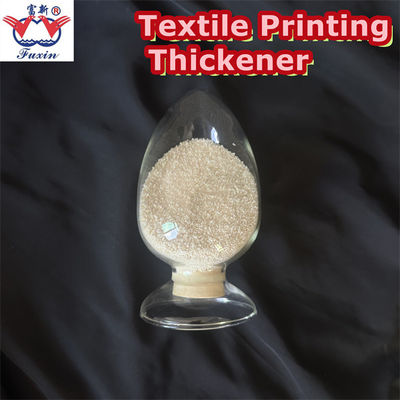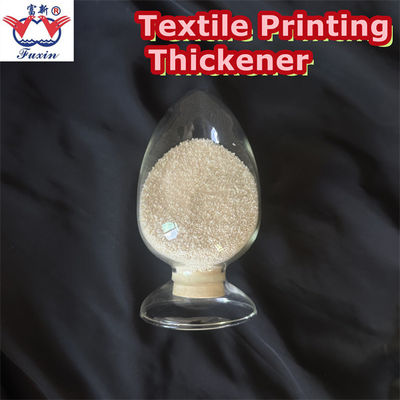High D.S. Reactive Printing Thickener for Textile Printing Industry
Product Description:
Reactive Printing Thickener is a chemical additive developed for textile printing. It is designed to deliver certain benefits, which include an enhanced viscosity for better control and stability during the printing process. This allows for an improved definition and sharpness of the printed designs. Additionally, this thickener can increase the strength and colorfastness of fabrics. Lastly, it is suitable for use in both the disperse and direct reactive dye printing processes.
Features:
Sodium Carboxymethyl Cellulose Aqueous Solution
Sodium carboxymethyl cellulose aqueous solution is a highly viscous and film-forming material. It has favorable stability and won't be affected by mechanical force, so it can be stored in a storage tank and does not require special temperature or bacteriological contamination. Furthermore, it can form a smooth and flexible film on the fabrics while providing a soft hand feel.
When used as a size, it can reduce the requirements of precise machinery and control instruments while avoiding the consumption of desizing agents. As a result, it simplifies the maintenance of mechanical equipment and improves the sanitary conditions of the workshop.
Apart from these benefits, the yarn count and fabric processed by aqueous solution will not lead to yellowing or mildewing, which helps reduce substandard goods and damages by worms or rats. In conclusion, sodium carboxymethyl cellulose aqueous solution has advantages in terms of production capacity, cost savings, and quality assurance.
Technical Parameters:


1st pic:Dyed color granular CMC 2% solution
2nd pic: The left is standard product made in Italy. The middle and right are Fuxin different types of CMC.
Specification
| TYPE |
Degree of Substitution (DS) |
Viscosity
(Brookfield,1%soln.,20℃)
|
pH |
Moisture |
Particle Size |
| 10H |
1 |
2500-3000cps |
6.5-8.5 |
≤15% |
20-70 mesh |
| 13H |
1.3 |
1500-2500cps |
| 15H |
1.5 |
1000-2000cps |
| 18H |
1.8 |
800-1600cps |
| Y002 |
2 |
800-1500cps |
| Y230 |
2.3 |
600-1000cps |
*Kindly contact us for specification and information about any specific grade of CMC other than mentioned in the above table.
Powder or granular available, we recomed customer to purchase the brown granle type CMC to sell as sodium alginate for higher profit.
Technique Process
▲Dissolve the dyes and add into the paste, make the color paste with thickener→▲Printing→▲Drying (100 ℃)→▲Baking or steaming→▲Washing→▲Soaping→▲Rinsing→▲Post treatment procedure.
Dissolution Methods and Proportion:
How to make the paste?
1. The ratio depends on DS level, low DS product should mix with pure sodium alginate to reach a better performance, while ultra high DS product can 100% replace SA.
2. Proportion: same as sodium alginate original paste preparing. Firstly add 65% water, stir the water while adding the product evenly and slowly, then speed up the stirrer for 20-25 minutes. And then add the remaining 35% water, stir for another 20-30 minutes. Leave for 15 minutes.
How to make sure the paste dissove completely?
1. Powder and water completely fuse, not exist solid-liquid separation phenomenon.
2. Paste is dissolved evenly, the surface is smooth, no granular objects.
Applications:
Reactive Printing Thickener
Reactive Printing Thickener is extensively used in the textile printing industry, primarily for reactive dye-based printing methods. It increases the viscosity of the printing paste, while also enhancing its rheological properties. This allows for precise and accurate application of reactive dyes onto fabrics, resulting in sharp and well-defined printed designs.
Reactive Printing Thickener also has an important role to play in fabric decoration. It facilitates the binding of reactive dyes onto the fibers of various fabrics, including cotton rayon, silk, and blends. This ensures excellent color fastness and resistance to fading, making it possible to create vibrant and intricate patterns on the fabric.
In apparel manufacturing, Reactive Printing Thickener is important for creating eye-catching printed designs on garments. It ensures consistent and uniform printing results, improving the overall finish and aesthetic appeal of the products.
Support and Services:
Reactive Printing Thickener Technical Support and Services
We offer a wide range of technical support and services for our Reactive Printing Thickener product, including:
- Detailed product information and usage instructions
- Product training and support
- Troubleshooting and repair services
- On-site product demonstrations
- Customized product solutions
Our team of experienced professionals are available to answer any questions or provide assistance with any problems you may have. We offer 24/7 customer service and are dedicated to providing the best customer experience possible.
Packing and Shipping:
Reactive Printing Thickener is packaged and shipped in 25 kg bags with an inner polyethylene lining. The bags are made of woven polypropylene and are heat sealed for added protection.
The bags are then placed into boxes or crates for shipping. The boxes are made of corrugated cardboard and are designed to protect the product from external elements such as moisture and dust.
The boxes are labeled with the product name, weight, date of manufacture, and any other relevant information to ensure safe and accurate delivery of the product.

 Your message must be between 20-3,000 characters!
Your message must be between 20-3,000 characters! Please check your E-mail!
Please check your E-mail!  Your message must be between 20-3,000 characters!
Your message must be between 20-3,000 characters! Please check your E-mail!
Please check your E-mail! 



